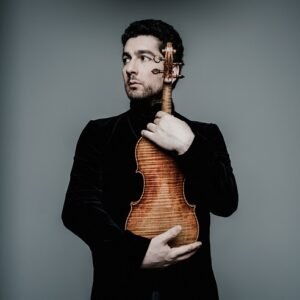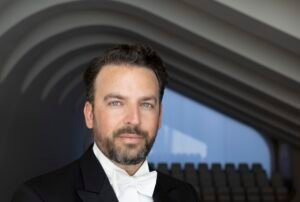FRIDAY, 22 h
30/08/2024
ORQUESTRA de la
COMUNITAT VALENCIANA
titular del PALAU DE LES
ARTS REINA SOFÍA
Sergey KHACHATRYAN, violí
James GAFFIGAN,
director titular



PROGRAM
Simfonia núm. 3 en fa major, op. 90 (1883)
Johannes Brahms (1833 – 1897)
I. Allegro con brio
II. Andante
III. Poco allegretto
IV. Allegro
PAUSA
Concert per a violí en re menor, op. 47 (1904)
Jean Sibelius (1865 – 1957)
I. Allegro moderato
II. Adagio di molto
III. Allegro, ma non tanto
Obertura Leonora núm. 3, op. 72B (1806)
Ludwig van Beethoven (1770 – 1827)
Orchestra of the Comunitat Valenciana
The Orquestra de la Comunitat Valenciana (OCV) was founded in 2006 by Lorin Maazel, its first musical director. In a short period of time, the resident orchestra of the Palau de les Arts has gained prestige among the public and critics, and has reached a high artistic level that places it among the best orchestras in Spain and one of the most important orchestras created in Europe in recent years. This recognition has also been forged thanks to the presence of Zubin Mehta in the first seasons, especially with the remembered Wagnerian Ring, and to maestros of the stature of Riccardo Chailly, Valery Gergiev or Gianandrea Noseda. Since September 2021, the American James Gaffigan has been the ensemble’s music director.
Praised for the quality of its musicians and for being a versatile ensemble capable of performing with admirable personality both opera and lyric-symphonic music, the OCV continues its professional trajectory driven by leading figures in orchestral conducting, among them Daniele Gatti, Fabio Luisi, Mark Elder or Antonello Manacorda, and expands its operatic repertoire with renowned international conductors specialized in different styles, such as Marc Albrecht, Maurizio Benini, Cornelius Meister, Riccardo Minasi and Marc Minkowski. It also strengthens the collaboration with the main Spanish conductors who have more projection outside our borders.
Sergey Khachatryan
Violin
Born in Yerevan, Armenia, Sergey Khachatryan won the first prize at the VIII International Jean Sibelius Competition in Helsinki in 2000, becoming the youngest winner in the history of this competition. In 2005 he won first prize at the Queen Elisabeth Competition in Brussels.
In the past season, Sergey’s international presence led him to perform with the Dresdner Philharmonie (Emmanuel Tjeknavorian), the Korean National Symphony Orchestra (Oksana Lyniv), the Ulster Orchestra (Daniele Rustioni), the Orchestre National de Belgique (Michael Schønwandt), the Queensland Symphony (Otto Tausk), or the Auckland Philharmonia (Chloé van Soeterstède), and a major North American tour with the Armenian National Philharmonic – among which were the great halls of Roy Thomson Hall in Toronto, the Maison Symphonique in Montreal and Carnegie Hall in New York.
Coming season 24/25, Sergey will return or make his debut with orchestras such as the Orchestra Accademia Santa Cecilia (Myung-Whum Chung), the Orchestra Sinfonica Nazionale della Rai (Cristian Macelaru), the Mozarteum Orchester Salzsburg (Han Na), or the San Diego Symphony Orchestra and Orchestre Symphonique de Montréal with Rafael Payare. In Spain, he will perform with the Orquesta de la Comunidad Valenciana (James Gaffigan), the Orquesta Sinfónica de Galicia (Anja Bihmaier), the Orquesta Sinfónica de Bilbao (Joana Carneiro), the Orquesta Sinfónica de Barcelona (Ludovic Morlot), or the Orquesta de Valencia with Alexander Liebreich.
In March 2024, Sergey released his latest CD in which he has recorded the 6 sonatas of Ysaÿe. What makes this project very special is that they are recorded on the 1740 Guarneri del Gesù “Ysaÿe”, the composer and violinist’s own instrument.
James Gaffigan
Music Director
James Gaffigan is acclaimed for his musicality and natural way of conducting. He stands out internationally as one of the most relevant American conductors on the music scene. He is music director of the Palau de les Arts and the Komische Oper Berlin, as well as principal guest conductor of the Netherlands Radio Philharmonic Orchestra and the Trondheim Simfoniorkester & Opera. He is also music director of the Verbier Festival Junior Orchestra. His period as chief conductor of the Lucerne Symphony has had a considerable influence on the orchestra’s profile, increasing tours and recordings, always with great success.
He collaborates with the most important orchestras, among them the Concertgebouw of Amsterdam, Paris, National of France, Age of Enlightenment, Bavarian Radio, Deutsches Symphonieorchester of Berlin, Staatskapelle of Dresden, Tonhalle of Zurich, Metropolitan of Tokyo, the symphonies of London, Vienna, WDR of Cologne and the BBC, as well as the philharmonic orchestras of Los Angeles, London and Munich. In the United States he has conducted the New York and Los Angeles philharmonics, the Cleveland and Philadelphia orchestras, as well as the Chicago, Montreal, Pittsburgh, St. Louis, San Francisco and Toronto symphonies, among others. As an opera conductor, Gaffigan is a regular at the Metropolitan in New York, Munich, Vienna, Hamburg, Chicago, Zurich, Amsterdam and Glyndebourne.
Gaffigan won first prize in the Sir Georg Solti International Conducting Competition in 2004. Since 2009, for a period of three years, he was associate conductor of the San Francisco Symphony, a position outlined for him by Michael Tilson Thomas. Previously he had been assistant conductor of the Cleveland Orchestra, where he worked with Maestro Franz Welser Möst. At Les Arts he has conducted Mozart’s Requiem, with staging of Romeo Castellucci, Wozzeck, La bohème, Tristan und Isolde, Lady in Spades, Die Zauberflöte and several concertos.
BRIEF DISSERTATION ON ROMANTICISM
Bàrbara Duran Bordoy
Today’s three protagonists allow us to glimpse the romantic movement development throughout the 19th century: Beethoven’s aesthetic and orchestral foundations, Brahms’s flamboyance and solidity, and the inspiration out of the traditional musical roots that mark Sibelius’s nationalism.
It is well known how Brahms feared the symphonic genre, which he considered to have reached its peak with Beethoven’s figure. Johannes Brahms’ (1833 – 1897) bonhomie was one of his defining traits. However, behind his figure as a composer rooted in tradition and impeccable formal structures is one of the musical creators with the most romantic and passionate heart about the entire mid-19th century.
In 1883, Antonin Dvorak visited Brahms in Vienna, who played this symphony’s opening and last movements for him. Dvorak clearly noticed the melodic motifs’ great beauty in Symphony No. 3, and his great friend Clara Schumann also grasped the formal condensation of each of the four beats. One element that stands out in this symphony is its significant density, cohesion, and variable rhythm, which moves across binary and ternary accents. An oscillating harmony between the major and minor modes should be added—a hallmark that allows Brahms to capture all the emotional tonalities.
The third of his symphonies can be defined as a flood of emotions that often displace those of the audience. Over the first half, the different topics tumultuously blast through. Brahms masterfully uses the woodwind to mark intersections that soothe the strings’ voices, which then rise in energetic and passionate waves that fluctuate amidst great rhythmic richness. At the same time, the motifs are lightly strung, cut short by the small pauses from the wind instruments setting the topic’s development. The second movement is headed by a calm start, the melodic ideas gradually developing between brief, calm passages to retake a more graceful nature. It is difficult to define the third movement of unique finesse. The soul of the purest romanticism dwells within this orchestral writing gem; there are no cracks in a music piece that captures fleeting beauty.
The opening movement’s energy returns in the fourth. Brahms uses motifs from previous sections, such as the second movement’s first theme – a trait that holds the work together and brings it closer to a symphonic poem’s design, with a programmatic idea behind it.
The Violin Concerto in D minor by Jean Sibelius was redone after the first première (1904) did not go as planned… Sibelius prefers a violin’s sustained prominence instead, so it is better to brace for a concert of significant technical difficulty. Right from the start, the soloist emerges with an almost unreal voice that soon stirs up a nearly silent orchestra, maintaining this tireless dialogue between soloist and orchestra throughout the three movements. Sibelius combines it with small groups of instruments that draw on a unique character far from a simple accompaniment, which brings it closer to the symphonic genre. The unreal world flair appears again in the last movement, with false harmonics by the soloist that deepen an otherworldly atmosphere. However, the concert holds a rare quality: a sharp contrast between passages beaming great beauty and an often dark and gloomy sonority.
Beethoven didn’t seem to care for jokes, but when the overture Leonora is scheduled, one wants to ask him: «Which of them all?» Beethoven did not have much luck with his opera Fidelio—it was poorly received, so he revisited his work, particularly the opening. Finally, the most frequently performed of the four versions is this evening’s Leonora No. 3.
While keeping the sonata form’s standard structure, Beethoven gradually adapted opera’s musical pieces: a slow introduction ends up interrupted by clarinets and bassoons that recall the aria sung by Florestan in prison. The violins contravene an arch-shaped piece that will give way to the supplementary piece, lyrically introduced by flutes and violins. After a highly dynamic section, a distant trumpet announces Florestan and Leonora’s release. Here, Maestro Beethoven lets himself be carried away by unleashing.
Four tries, indeed. But Leonora No. 3 is worth it.
SPONSORS

FINANCED BY


WITH THE SUPPORT OF

OFFICIAL MEDIA

